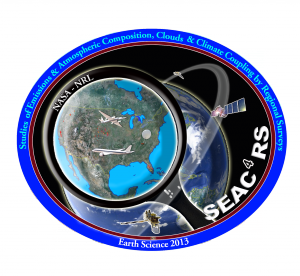WASHINGTON -- NASA will host a media teleconference at 1 p.m. EDT,
Thursday, June 6, to announce a new airborne science campaign over the
southern United States. The campaign will investigate how air pollution
and natural emissions affect climate and the atmosphere.
The Studies of Emissions, Atmospheric Composition, Clouds and Climate Coupling by Regional Surveys campaign, or SEAC4RS, is NASA's most complex airborne mission of the year. The mission targets summertime emissions from intense forest fires in the U.S. West and natural emissions from forests in the Southeast. Flights begin in August from Houston's Ellington Field and continue through September.
The panelists for the teleconference are:
-- Brian Toon, SEAC4RS principal investigator, Department of Atmospheric and Oceanic Sciences, University of Colorado, Boulder
-- Hal Maring, radiation sciences program manager, Earth Science Division, Science Mission Directorate, NASA Headquarters, Washington
To dial-in to the teleconference, reporters must contact Steve Cole at 202-358-0918 or stephen.e.cole@nasa.gov with their media affiliation by 11 a.m., June 6. Questions also can be submitted via Twitter during the briefing by using the hashtag #askNASA.
To listen to the briefing live on NASA's website, visit:
The Studies of Emissions, Atmospheric Composition, Clouds and Climate Coupling by Regional Surveys campaign, or SEAC4RS, is NASA's most complex airborne mission of the year. The mission targets summertime emissions from intense forest fires in the U.S. West and natural emissions from forests in the Southeast. Flights begin in August from Houston's Ellington Field and continue through September.
The panelists for the teleconference are:
-- Brian Toon, SEAC4RS principal investigator, Department of Atmospheric and Oceanic Sciences, University of Colorado, Boulder
-- Hal Maring, radiation sciences program manager, Earth Science Division, Science Mission Directorate, NASA Headquarters, Washington
To dial-in to the teleconference, reporters must contact Steve Cole at 202-358-0918 or stephen.e.cole@nasa.gov with their media affiliation by 11 a.m., June 6. Questions also can be submitted via Twitter during the briefing by using the hashtag #askNASA.
To listen to the briefing live on NASA's website, visit:
For more information on the mission, visit:
SEAC4RS
Studies of Emissions and Atmospheric Composition, Clouds and Climate Coupling by Regional Surveys
(SEAC4RS)
1. To determine how pollutant emissions are redistributed via deep convection throughout
the troposphere.
2. To determine the evolution of gases and aerosols in deep convective outflow and the
implications for UT/LS chemistry.
3. To identify the influences and feedbacks of aerosol particles from anthropogenic
pollution and biomass burning on meteorology and climate through changes in the
atmospheric heat budget (i.e., semi-direct effect) or through microphysical changes in
clouds (i.e., indirect effects).
4. To serve as a calibration/validation test bed for future satellite instruments and
missions.
Attention will also be given to the influence of biomass burning and
pollution, their temporal evolution, and ultimately impacts on
meteorological processes which in turn feed back into regional air
quality. With respect to meteorological feedbacks, the opportunity to
examine the impact of polluting aerosols on cloud properties and
ultimately dynamics will be of particular interest.To accomplish the goals of SEAC4RS, two aircraft are required. The NASA DC-8 will provide observations from near the surface to 12 km, and the NASA ER-2 will provide high altitude observations reaching into the lower stratosphere as well as important remote sensing observations connecting satellites with observations from lower flying aircraft and surface sites.
NASA
Guillermo Gonzalo Sánchez Achutegui
ayabaca@gmail.com
ayabaca@hotmail.com
ayabaca@yahoo.com
Inscríbete en el Foro del blog y participa : A Vuelo De Un Quinde - El Foro!



No hay comentarios:
Publicar un comentario